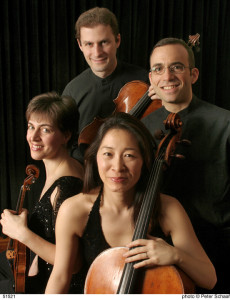 July 17, 2013. Walter Hall, Toronto.
July 17, 2013. Walter Hall, Toronto.
Toronto streets last night were hot enough to bake a baguette, but the second concert of the Toronto Summer Music Festival was a very cool scene. The Brentano Quartet, currently hyped as celebrities for their “heaven sent” playing of Beethoven behind Christopher Walken and Philip Seymour Hoffman in the hit film The Late Quartet, more than lived up to the hype. They brought insight to the Beethoven and Dvorak selections, and their Debussy had a “can’t take my ears off of you” effect.
The Beethoven was an early quartet, Op.18. No. 3 in D Major from 1800, when the composer was just beginning to find his authentic voice in string quartets. Mark Steinberg’s opening solo violin catches the leisurely sweetness of Beethoven’s new voice and the hint of a lilt that lifts it up even in melancholy passages that follow. The Brentano’s timbre in unison is fine-grained, less velvet and more like silk watermarked by the ample waves of Nina Marie Lee’s cello, who impressed with her focus, especially during the slow second movement where the ensemble’s tension seemed to slacken. The Brentano’s phrasing was nicely shaped throughout the rather slow scherzo. The musical lilt that distinguishes the Brentano’s insight into this particular Beethoven returned in the finale, animated their tight unison work, and moved the audience to shout out their pleasure.
Debussy wrote only one string quartet, the G Minor Op. 10 of 1893. In it he captured the essence of what is meant by La Belle Époque, this year’s Festival sub-title. La Belle Époque refers to the period (1870-1914) between France’s two wars with Germany. From the point of view of music it signified the radical break with the dominant German influence in European music from Beethoven to Wagner. It was Debussy who established the break in France by bringing in new sonic materials–scales from Gamelan, unusual chords, progressions, modal keys, as well as his own personal genius for unheard melodies and harmonies. Debussy’s arrangements of these materials—the swift tempo changes, shimmering pulsations and nuanced durations— helped to create a new “French” world of music. The Brentano’s version of Debussy’s String Quartet brought the energy of La Belle Époque to life, as if for the first time—an illusion of course, but a magical one.
After intermission, the Brentano’s were joined by pianist Pedja Muzijevic for the longest work of the evening, Piano Quintet No. 2 in A Major, Op.18.B.155 by Antonin Dvorák. Dvorak, himself a violist, wrote some exceptionally lovely passages in the second movement that allowed Brentano violist Misha Amory a rare opportunity to blend his velvety solo voice with Muzijevic’s lacy piano. On the whole, though, as a segué to their living gossamer of the Debussy, the Brentano’s Dvorák sounded too big and forceful, missing the lilt distinguishing the folk-dances that inspire so much of this composer’s work. That said, they did highlight how much of Dvorák’s music rhapsodizes nostalgically on scenes of a pastoral past. In my opinion, it was too heavy a dessert-wine following a delicate meal on a hot evening. The work was enthusiastically received. There was no encore.
